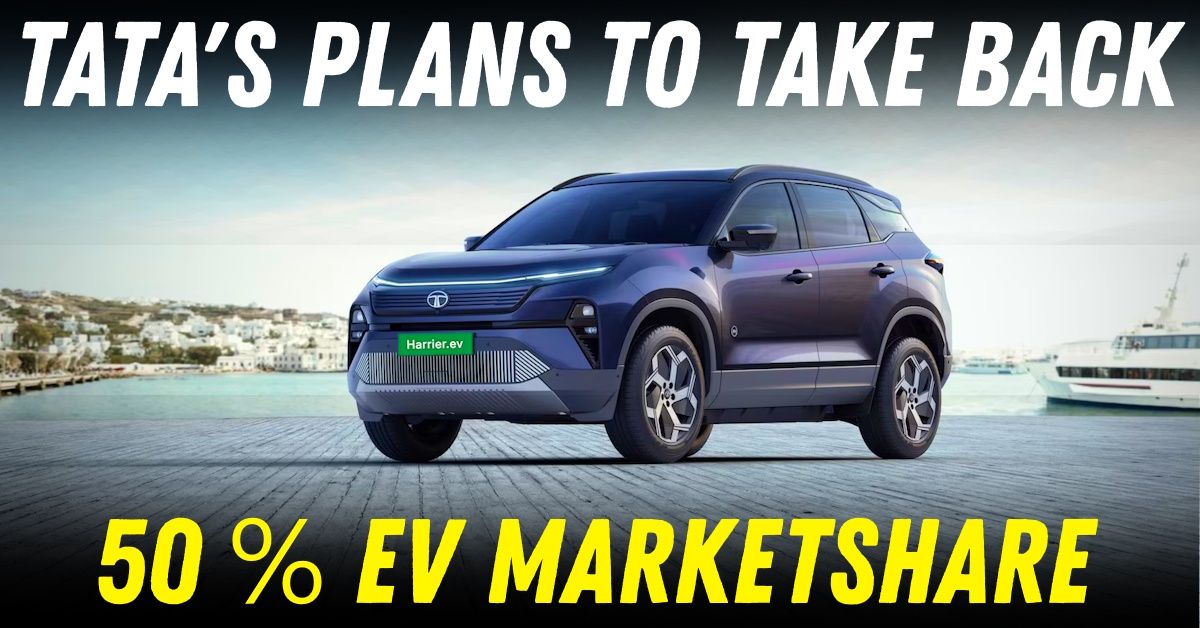Tata Motors Wants To Regain 50 % Market Share In Electric Car Segment: Plans Revealed


Tata Motors once towered over India’s electric vehicle (EV) market with a commanding 73% share in 2023. But by early 2025, that figure had slipped drastically to just over 38%. The decline has been sharp and telling, driven by an evolving competitive landscape, changing buyer segments and a temporary vacuum in Tata’s own product pipeline. Rivals like MG Motor have rapidly gained ground, thanks largely to the success of models like the Windsor, while Mahindra and BYD have also found footing in urban and semi-urban markets.
Shailesh Chandra, Managing Director of Tata Motors Passenger Vehicles and Tata Passenger Electric Mobility, acknowledged the dip but maintained that the company’s sights remain firmly set on reclaiming 50% of the EV market.
Speaking to Autocar Professional, Chandra said that while a fall in market share was expected due to rising competition, the volume drop was not. The statement offers both a reality check and a forward-looking promise from a company that helped mainstream EVs in India.
The drop in share wasn’t just about rival brands. Tata Motors itself had to phase out certain legacy products and platforms as it transitioned to newer architectures. Additionally, the withdrawal of the FAME II subsidy and a cooling off in the fleet segment, particularly employee transport and aggregator-driven purchases, exacerbated the dip. But the company is not sitting idle.
Chandra pointed out that Tata Motors is now doubling down on what he calls “micro-segmentation” to address EV adoption across varied price points and use cases. In the ₹8–12 lakh band, which includes models like the Tiago EV and Punch EV, Tata still commands nearly 75% market share. However, this category remains relatively small. The plan here is to further enhance the value proposition so that the entry-level EV market expands organically.
In the ₹12–20 lakh bracket, competition has been intense. The MG Windsor’s entry reshaped buyer expectations, and Tata’s market share has stabilised around 33% in this segment. Chandra emphasised the importance of tailoring offerings better, both in terms of pricing and features. The premium end, with models priced above ₹20 lakh, remains a long-term play but is very much part of the future roadmap.
Meanwhile, the company is rethinking its approach to the fleet market, which has seen a sudden decline in demand. Chandra said this segment remains important, but Tata would now approach it more selectively and based on the evolving needs of B2B customers.
Beyond market segmentation, Tata Motors is focusing on the broader EV ecosystem. A key challenge across India remains the lack of accessible charging infrastructure, especially in Tier 2 and Tier 3 cities. Chandra confirmed that Tata is working closely with partners to address this bottleneck, not just by adding more chargers but by optimising locations and technology to make usage seamless.
Product innovation is another front where the company intends to strike back. While the older Ziptron platform served Tata well, upcoming models will be based on more modular, scalable Acti.EV architectures that promise better efficiency, range and features. Tata has also indicated a clear move towards incorporating more connected car tech, AI-based diagnostics and improved battery management systems to stand out in the next phase of EV growth.
Reclaiming a 50% share in India’s EV market will not be easy. Tata Motors now faces stronger competition than ever before, and consumer expectations have evolved rapidly. But the company still enjoys strong brand equity, an established charging network, and an early-mover advantage in EV familiarity among Indian buyers.
Chandra’s statement underscores a renewed long-term focus.
“We have a robust strategy in place to sustain our market share and grow,” he said, framing this not as a quick fix but a patient rebuild based on deeper market insights and product evolution.
If Tata can execute on these fronts, its aim to return to dominance may no longer seem far-fetched. For now, however, the road ahead is uphill, and it will take more than just ambition to climb back to the top.